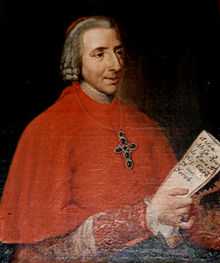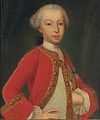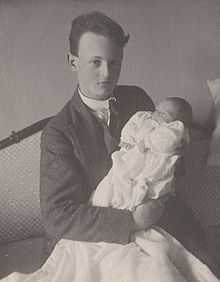Jacobite succession
The Jacobite succession is the line through which the crown in pretence of England and Scotland and Ireland has descended since the flight of James II & VII from London at the time of the "Glorious Revolution". James and his Jacobite successors were traditionally toasted as "The King over the Water". Due to their descent from Charles I, as compared to the descent of Queen Elizabeth II from his sister Elizabeth Stuart, Queen of Bohemia.
House of Stuart
The Stuarts who claimed the thrones of England, Scotland, Ireland and France after the Glorious Revolution of 1688 were, with the dates of their claim:
| Descendant and Dates of Claim | Portrait | Birth | Marriages | Death |
|---|---|---|---|---|
| James II & VII 11 December 1688 (England & Ireland) / 14 March 1689 (Scotland) – 16 September 1701[1] |  | 14 October 1633 St. James's Palace son of Charles I and Henrietta Maria of France[1] | Anne Hyde 3 September 1660 8 children Mary of Modena |
16 September 1701 Château de Saint-Germain-en-Laye aged 67[1] |
| James Francis Edward Stuart ("James III & VIII") ("The Old Pretender") 16 September 1701– 1 January 1766 |  | 10 June 1688[2] St. James's Palace son of James II of England and Mary of Modena | Clementina Sobieski 3 September 1719 2 children | 1 January 1766 Palazzo Muti aged 77 |
| Charles Edward Stuart ("Charles III") ("The Young Pretender") ("Bonnie Prince Charlie") 1 January 1766– 31 January 1788 |  | 31 December 1720[3] Palazzo Muti son of James Francis Edward Stuart and Clementina Sobieski | Princess Louise of Stolberg-Gedern 28 March 1772 no children (2 illegitimate children) | 31 January 1788 Palazzo Muti aged 67 |
| Henry Benedict Stuart ("Henry IX & I") ("Cardinal Duke of York") 31 January 1788– 13 July 1807 |  | 11 March 1725[4] Rome son of James Francis Edward Stuart and Clementina Sobieski | never married | 13 July 1807 Frascati aged 82 |
Upon Henry's death, the succession passed to a different house, and none of the Jacobite heirs since has actually claimed the thrones of England and Scotland or incorporated the arms of England and Scotland in their coats-of-arms.
House of Savoy
Charles Emmanuel IV of Sardinia was a descendant of Charles I through his youngest daughter Henrietta Anne. Her daughter Anne Marie of Orléans married Victor Amadeus II of Sardinia, and Charles Emmanuel IV was great-grandson of Queen Anne Marie in the male line.
| Descendent and Dates of Claim | Portrait | Birth | Marriages | Death |
|---|---|---|---|---|
| Charles Emmanuel IV of Sardinia ("Charles IV") 13 July 1807– 6 October 1819 |  | 24 May 1751 Turin son of Victor Amadeus III of Sardinia and Maria Antonietta of Bourbon | Marie Clotilde of France 1775 No children | 6 October 1819 Rome aged 68 |
| Victor Emmanuel I of Sardinia ("Victor") 6 October 1819– 10 January 1824 |  | 24 July 1759 Turin son of Victor Amadeus III of Sardinia and Maria Antonietta of Bourbon | Maria Teresa of Austria-Este 21 April 1789 7 children | 10 January 1824 Moncalieri aged 65 |
| Maria Beatrice of Savoy ("Mary III & II")[5] 10 January 1824– 15 September 1840 |  | 6 December 1792 daughter of Victor Emmanuel I of Sardinia and Maria Teresa of Austria-Este | Francis IV, Duke of Modena 20 June 1812 4 children | 15 September 1840 aged 48 |
House of Austria-Este
| Descendent and Dates of Claim | Portrait | Birth | Marriages | Death |
|---|---|---|---|---|
| Francis V, Duke of Modena ("Francis I") 15 September 1840– 20 November 1875 |  | 1 June 1819 Modena son of Maria Beatrice of Savoy and Francis IV, Duke of Modena | Adelgunde of Bavaria 30 March 1842 1 child | 20 November 1875 Vienna aged 56 |
| Maria Theresia of Austria-Este ("Mary IV & III")[5] 20 November 1875– 3 February 1919 |  | 2 July 1849 Brno daughter of Ferdinand of Austria-Este[6] and Elisabeth of Austria | Ludwig III of Bavaria 13 children | 3 February 1919 Chiemgau aged 69 |
House of Wittelsbach
| Descendent and Dates of Claim | Portrait | Birth | Marriages | Death |
|---|---|---|---|---|
| Rupprecht, Crown Prince of Bavaria ("Robert I & IV") 3 February 1919– 2 August 1955 |  | 18 May 1869 Munich son of Maria Theresia of Austria-Este and Ludwig III of Bavaria | Marie Gabrielle of Bavaria 10 July 1900 Munich 4 children Antonia of Luxembourg 7 April 1921 Lenggries 6 children | 2 August 1955 Schloß Leutstetten aged 86 |
| Albrecht, Duke of Bavaria ("Albert") 2 August 1955– 8 July 1996 |  | 3 May 1905 Munich son of Rupprecht, Crown Prince of Bavaria and Marie Gabrielle of Bavaria | Countess Maria Draskovich of Trakostjan 1930 4 children Countess Marie-Jenke Keglevich of Buzin 1971 No children | 8 July 1996 Castle Berg aged 91 |
| Franz, Duke of Bavaria ("Francis II") 8 July 1996– present |  | 14 July 1933 Munich son of Albrecht, Duke of Bavaria and Countess Maria Draskovich of Trakostjan | not married |
Future descent after the Duke of Bavaria
The heir presumptive of Franz, Duke of Bavaria, is his younger brother
- Prince Max, Duke in Bavaria. Then his daughter
- Sophie, Hereditary Princess of Liechtenstein, and then her eldest son
- Prince Joseph Wenzel of Liechtenstein, born 24 May 1995 in London. The first heir in the Jacobite line born in the British Isles since James III and VIII, The Old Pretender in 1688.
- Sophie, Hereditary Princess of Liechtenstein, and then her eldest son
Family tree
This is a family tree of the above Jacobite successors, the boldface names are successors, and the italic names are in line of succession.
Alternative successions
While Franz of Bavaria is recognized by most Jacobites as the Stuart heir, arguments have been made for several other candidates.
Alicia
Maria Beatrice of Savoy married her uncle Francis IV, Duke of Modena. This marriage was concluded validly in Sardinia.[citation needed] However, it would have been illegal for them to marry in Britain, and therefore the Jacobite succession is considered by some[citation needed] to have passed from Maria Beatrice to her younger sister Maria Teresa, who married the Duke of Parma. Her representative today is HRH The Infanta Alicia (b. 1917), dowager Duchess of Calabria and mother of the heir of the Kingdom of the Two Sicilies.[7]
The succession from Maria Teresa is as follows.
| Descendent | Portrait | Birth | Marriages | Death |
|---|---|---|---|---|
| Maria Teresa of Savoy ("Mary IV & III") 15 September 1840– 16 July 1879 |
 |
19 September 1803 Palazzo Colonna daughter of Victor Emmanuel I of Sardinia and Maria Teresa of Austria-Este |
Charles II, Duke of Parma 5 September 1820 Lucca (2 children) |
16 July 1879 aged 75 |
| Descendent | Portrait | Birth | Marriages | Death |
|---|---|---|---|---|
| Robert I, Duke of Parma ("Robert I and IV") 16 July 1879– 16 November 1907 |
 |
9 July 1848 Florence son of Charles III, Duke of Parma and Louise Marie Thérèse of France |
Maria Pia of the Two Sicilies 5 April 1869 Rome (12 children) Maria Antonia of Portugal 15 October 1884 Schloß Fischhorn (12 children) |
16 November 1907 Viareggio aged 59 |
| Henry, Duke of Parma ("Henry X and II") 16 November 1907– 16 November 1939 |  |
13 June 1873 Wartegg son of Robert I, Duke of Parma and Maria Pia of the Two Sicilies |
never married | 16 November 1939 Pianore aged 66 |
| Joseph, Duke of Parma ("Joseph") 16 November 1939– 7 January 1950 |
 |
30 June 1875 Biarritz son of Robert I, Duke of Parma and Maria Pia of the Two Sicilies |
never married | 7 January 1950 Pianore aged 74 |
| Elias, Duke of Parma ("Elias") 7 January 1950– 27 June 1959 |
23 July 1880 Biarritz son of Robert I, Duke of Parma and Maria Pia of the Two Sicilies |
Maria Anna of Austria-Teschen 25 May 1903 Vienna (8 children) |
27 June 1959 Friedberg aged 78 | |
| Robert II, Duke of Parma ("Robert II and V") 27 June 1959– 25 November 1974 |
 |
7 August 1909 Weilburg son of Elias, Duke of Parma and Maria Anna of Austria-Teschen |
never married | 25 November 1974 Vienna aged 65 |
| Elisabetta of Bourbon-Parma ("Elizabeth II and I") 25 November 1974– 13 June 1983 |
17 March 1904 Vienna daughter of Elias, Duke of Parma and Maria Anna of Austria-Teschen |
never married | 13 June 1983 Bad Ischl aged 79 | |
| Maria Francesca of Bourbon-Parma ("Mary V & IV") 13 June 1983– 20 February 1994 |
5 September 1906 Weilburg daughter of Elias, Duke of Parma and Maria Anna of Austria-Teschen |
never married | 20 February 1994 Fribourg aged 87 | |
| Alicia, Duchess of Calabria ("Alice") 20 February 1994– present |
13 November 1917 Vienna daughter of Elias, Duke of Parma and Maria Anna of Austria-Teschen |
Infante Alfonso, Duke of Calabria 16 April 1936 Vienna (3 children) |
Victor Emmanuel
In the early twentieth century Frederick Rolfe claimed that King Victor Emmanuel III of Italy was the rightful King of England, as heir to the Kings of Sardinia.
In 1831 the male descendants of Victor Amadeus II of Sardinia and his wife Anne Marie d'Orléans, a niece of James II, died out and the Savoy succession – but not the Jacobite succession – passed to a distant cousin, because the succession in the Kingdom of Sardinia was governed by the Salic Law, which does not recognize claims by or through a female. England and Scotland have never been subject to the Salic Law (if they were, the succession could not have passed to the house of Savoy, nor in fact could the House of Stuart have inherited the thrones of either Scotland or England, as their claims in the two kingdoms derived, respectively, from Marjorie Bruce and Margaret Tudor). Rolfe may not have understood this.
Elizabeth
In his book The Highland Clans, Iain Moncreiffe of that Ilk claimed that Elizabeth II of the United Kingdom "is the lawful Jacobite sovereign of this realm". Moncreiffe made the following argument:
... by the fourteenth century it had become common law (in both England and Scotland) that a person who was not born in the liegeance of the Sovereign, nor naturalised, could not have the capacity to succeed as an heir .... In Scotland, this law was modified in favour of the French from the sixteenth century, but was otherwise rigorously applied until the Whig Revolution of 1688, after which it was gradually done away with by the mid-nineteenth century. It was precisely because of this law that Queen Anne found it necessary to pass a special Act of Parliament naturalising all alien-born potential royal heirs under her Act of Settlement of the throne. But, of course, from the Jacobite point of view, no new statute could be passed after 1688 .... The nearest lawful heir of the Cardinal York in 1807 was, in fact, curiously enough, King George III himself, who had been born in England (and therefore in the technical liegance of James VIII).
Under Moncreiffe's theory, however, James VI of Scotland could never have succeeded as James I of England in 1603. This problem, recognized in 1603, had been circumvented at the time of James's accession by the ahistorical assertion that Scotland and England had been "anciently but one" kingdom, and that the succession of the Scottish monarch to the throne of England was a "reuniting" of two parts of a single kingdom, i.e., that Scotland was not really a foreign country – a concept emphasized by James's insistence on the use of the name Great Britain for the united realms of England and Scotland.
It was not common law but a 15th-century statute that restricted the English crown to those in the liegeance of the Sovereign, and that statute was supplanted by the Acts of Succession passed in Henry VIII's reign. Additionally, Jacobites believe that the royal succession is determined by God and by hereditary right, not by Parliament. For instance, most Jacobites recognise Mary, Queen of Scots as having been the rightful Queen of England – a clear violation of the aforementioned law, which in their view is overridden by Mary's hereditary rights (as granddaughter of Margaret Tudor), and the illegitimacy[8] of Elizabeth I.[9][10][11]
Another interesting question raised by Moncreiffe's theory is that had the Act of Settlement not been passed, then George III would probably not have been born in Britain and so the House of Hanover as well as the House of Savoy would have had to be bypassed on Cardinal York's death, which would mean that he would have had different heirs to Scotland and England as all post-Union of the Crowns lines (i.e. Stuart, Savoy and Hanover) would either be extinct (Stuart) or barred from the succession on the grounds of being foreign (Savoy and Hanover). The logical thing to happen in this instance would have been for parliament to introduce legislation allowing the closest relatives (i.e. The House of Savoy, specifically Charles Emmanuel IV and his family) to be in the line of succession, as was actually done for the closest Protestant relatives of Queen Anne (The House of Hanover; Princess Sophia and her family) via the Sophia Naturalisation Act which ensured the succession as laid down by the Act of Settlement, and confirmed in the Treaty of Union.[citation needed]
Royal family tree

See also
|
- History of the Jacobite line of succession
- Alternative successions of the English crown
- Jacobite consorts
References
- ↑ 1.0 1.1 1.2 1.3 "thePeerage.com – Person Page 10136". Retrieved 2007-10-25.
- ↑ "Stuart, James Francis Edward, Duke of Cornwall". Directory of Royal Genealogical Data: University of Hull. Retrieved 2008-03-21.
- ↑ "Stuart, Charles Edward Louis Casimer, Prince of Wales". Directory of Royal Genealogical Data: University of Hull. Retrieved 2008-03-21.
- ↑ "Stuart, Henry Benedict Thomas Maria, Duke of York". Directory of Royal Genealogical Data: University of Hull. Retrieved 2008-03-21.
- ↑ 5.0 5.1 Mary III & II and Mary IV & III were numbered in such a way because some Jacobites regard Elizabeth I of England as illegitimate, and therefore consider Mary, Queen of Scots, to have been the rightful Queen Mary II of England from the death of Mary I
- ↑ Ferdinand was the second son of Francis IV
- ↑ "The Infanta Alicia of Spain". Jacobite.ca. Retrieved 2008-07-19.
- ↑ Hibbert, Christopher (1992). The virgin queen: Elizabeth I, genius of the Golden Age. DaCapo Press. p. 149. ISBN 978-0-201-60817-5.
- ↑ Tudor Monarchs – Queen Elizabeth I: Biography, Portraits, Primary Sources. Englishhistory.net. Retrieved on 2012-07-15.
- ↑ http://www.time.com/time/magazine/article/0.9171,937040,00.html. Missing or empty
|title=(help) - ↑ Jenkins, Elizabeth (2000). Elizabeth the Great. Phoenix Press. ISBN 978-1-84212-162-7.
.svg.png)